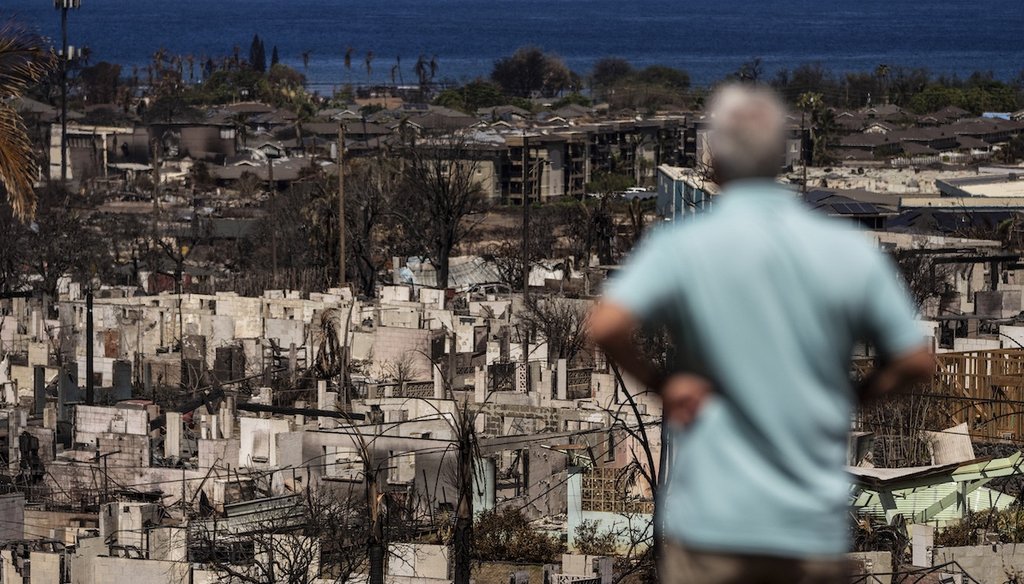PolitiFact – What are ‘smart cities’ and why are conspiracy theorists linking them to wildfires?

The concept of a “smart city” — one that uses technology to run more efficiently — is nothing new and has been around for about two decades. The cities embrace the use of digital tools, such as networks of sensors and cameras, to help improve traffic flow, public transit and electrical grids.
Smart cities have been at the center of baseless claims that they are part of a government plot to control people. Now, after a summer filled with natural disasters, a new unfounded claim has emerged.
Following wildfires in Hawaii, Canada, Spain’s Canary Islands and Greece, rather than blame likely culprits such as record heat, climate change or downed power lines, social media users say the wildfires were intentionally set to clear the way for smart cities.
One Instagram post made that false claim after the Maui, Hawaii, wildfires, tying it to a January technology conference during which smart cities were among many topics discussed. Similar claims have been amplified by conservative personalities with large followings, such as Turning Point USA CEO Charlie Kirk and InfoWars host Alex Jones.
A TikTok post, liked nearly 11,000 times by Sept. 12, showed where wildfires were happening throughout the U.S. “I’m going to show you what’s going on in those states and why there’s fires,” a woman in the video said. She then displayed screenshots of city websites detailing smart city initiatives, baselessly connecting them to nearby wildfires.
But there is no connection between smart cities and wildfires or any other natural disasters. Most smart city technology is small-scale and incremental — such as adding software and sensors — and doesn’t require destroying anything in a city to implement it. Some smart city technologies are being used to help detect and stop wildfires.
The reason smart city initiatives often are found in or near cities that experienced wildfires is not nefarious. It’s simple: smart city plans are ubiquitous. If you’re reading this story, chances are your city has embraced some smart city technology, too.
What is a ‘smart city’?
It’s a term “that’s been used so many times that it sort of lost all meaning,” said Shoshanna Saxe, an associate professor in the University of Toronto’s Department of Civil & Mineral Engineering. “It means a lot of different things to different people.”
In its most complete (and theoretical) form, sensors, computer programs and robots could run all of a city’s functions, such as water flow, trash pickup and transportation. But smart cities like that “don’t exist anywhere in the world,” Saxe said. Rather, she said, cities often use the term to describe simpler things, such as creating an app for residents to contact the city, or an open data platform for researchers and developers.
“A lot of the stuff people are currently calling their smart-city initiatives are really run of the mill operating a city in the 21st century,” Saxe said. An example is using smart electric grids to more efficiently meet energy needs.
Anthony Townsend, an urbanist-in-residence at the Jacobs Technion-Cornell Institute at Cornell Tech, and the author of a 2013 book about smart cities, thinks of them as a movement.
Townsend said dozens, if not hundreds, of U.S. cities have some sort of smart city initiative or digital plan; one was just announced in July in San Antonio.
The projects involve collaboration from multiple stakeholders, not just city governments, Townsend said. Some private large-scale real estate developers invest in and use sophisticated technology, even though they may not always brand the developments as smart cities.
Townsend cited recent projects in Arizona and Utah, where the “first car-free neighborhood in the U.S.” and a development focused on walkability opened. Culdesac, the Arizona project, allows residents to forgo personal vehicles by providing access to ride-sharing services, including electric and autonomous vehicles. The development includes ample bicycle parking and scooters to use for short rides to get essential items, which are usually located within 5 minutes, its website says.
“Neither of those talk a lot about technology up front, but when you dig in it’s pretty clear technology is going to be a big part of how they work,” Townsend said.
There are smart city projects around the world, said Josh O’Kane, author of a book about a failed Toronto smart-city project and a longtime business reporter with The Globe and Mail, Canada’s largest national newspaper.
O’Kane cited a Brazil operations center that monitors traffic and weather to provide residents with real-time information, especially during emergencies. And he pointed to Miovision, a private Canadian company that offers cities its services to monitor traffic.
Fear, privacy concerns drive suspicion about smart cities
The concept’s critics, many of whom distrust big technology corporations or fear government overreach, worry about insufficient guardrails for data privacy and surveillance. The scrapped multimillion dollar smart cities project in Toronto led by a Google affiliate was one example where those concerns weren’t addressed.
Toronto in 2017 announced a partnership with Google sister company Sidewalk Labs to create a tech-focused neighborhood on undeveloped land. The project was canceled in May 2020 after critics raised concerns about data privacy. Sidewalk Labs blamed the project’s end on uncertainty about the COVID-19 pandemic.
O’Kane said Sidewalk Labs’ affiliation with Google was part of what fueled opponents’ concerns.
“Google fundamentally built the economy of the internet on data collection,” O’Kane said. “Big Tech companies tend to bring this reputation, even if they promise to avoid or minimize data collection in city projects.”
People easily could have read about the proposed Toronto project and “extrapolat(ed) that mass data collection could be the norm in smart cities,” O’Kane said.
Because the smart city concept has never been fully defined, he said, “people the world over have tended to project their fears, and occasionally hopes, onto the label.”
Townsend said smart cities often include “trigger technologies” — ones that tend to raise people’s suspicions — such as 5G cellular technology, facial recognition software and self-driving cars. He said several dozen U.S. cities have banned law enforcement from using facial recognition software because of concerns about implicit bias.
Some autocratic countries, such as China, have used technology for mass surveillance of their residents. But in North America and Europe, governments and smart city collaborators must follow more rigid privacy laws, Townsend and Saxe said.
North American smart city advocates are not proposing to surveil citizens, Saxe said.
Ultimately, smart city initiatives are drafted and approved by public governments, and residents, through their elected officials, have a say in how or whether they are implemented.
“A key point is that where you have communities that have said we want to slow this down or stop it, they have been empowered to do that,” Townsend said, citing efforts by some cities to ban facial recognition usage. “There isn’t some sinister (corporation) or government forcing it upon them. They had the democratic processes to regulate the technology and they’re using them. That’s all as it should be.”
Is there any evidence wildfires have been intentionally set to make way for smart cities?
There is no evidence to support that claim, and experts say it doesn’t make sense based on how smart cities are developed.
Cities don’t need to destroy existing development in order to implement smart city technology. The technologies being deployed mostly involve adding sensors or software to existing infrastructure. Larger projects have involved private companies proposing “smart” developments on undeveloped land, such as the scuttled Toronto plan, or a planned smart city for 100,000 people in Oman.
Saxe said that after a disaster, governments tend to build back infrastructure the way it was before, because of time and cost constraints. And Townsend said upgrading or retrofitting current infrastructure is more economically feasible than building it from scratch.
People linking smart cities and wildfires might be surprised to learn that some smart city technologies are used to detect and stop wildfires.
In Oakland, California, firefighters are testing a pilot program that installed 10 sensors to detect wildfires by sampling air quality, and then notify the fire department.
Similarly, Sonoma County, California, added artificial intelligence software to an existing network of cameras to help with early detection of wildfires. The National Fire Protection Association, a nonprofit group that has been studying smart technology, says it opens “new possibilities for the fire service to address unwanted fires.”
“If anything, smart city solutions are probably contributing a great deal to reducing wildfire risk, particularly related to electric power grids,” said Townsend. He said electric power utilities are using data, AI and satellite imagery to identify wires, transformers and other equipment that are at risk of failing.
Disasters often lead to misinformation
Mike Caulfield, a research scientist who leads the University of Washington’s Center for an Informed Public, said misinformation after disasters is not uncommon. Caulfield said the randomness of such events, which are often the result of compound failures, can lead some to blame the government.
“When you look at something like Maui, there’s the weather, there’s — possibly, but not definitely — climate change. There’s land management issues, response issues, infrastructure issues, communication issues,” he said. “Some people have trouble looking at a sizable event like that and seeing it as a confluence of factors. It seems unsatisfactory.”
Though these claims have emerged in some circles on social media, that doesn’t mean they’ve widely taken hold among the public, said Joseph Uscinski, a University of Miami political professor who has researched conspiracy theories.
“People who have a strong conspiratorial worldview see conspiracies behind many events and circumstances,” he said. “People conspiracy-theorized about social security numbers, airline security and many other similar things.”
Caulfield said conspiracy theories often are driven by shifts in power.
The idea of a smart city means that “a new way of life is winning, and it is going to leave an old way of life behind,” Caulfield said.
There are valid concerns about smart cities, such as surveillance and “elite control of public spaces,” Caulfield said, but most people with such concerns try to seek out the best information possible.
“But for many of the conspiracy theorists, it’s more of a story about who has power — their enemies — and how dangerous those enemies are.”
This article has been archived for your research. The original version from PolitiFact can be found here.


